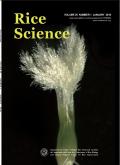感染植物病原真菌 Ustilaginoidea virens 的新型丝状病毒的分子和生物学特性鉴定
IF 5.6
2区 农林科学
Q1 AGRONOMY
引用次数: 0
摘要
水稻假黑穗病(Rice false sm黑穗病,RFS)是由子囊菌真菌Ustilaginoidea virens (Cooke) Takahashi引起的水稻穗部病害。分枝病毒是一类能够感染各种真菌群的病毒,因其在植物真菌病害生物防治中的潜在应用而引起人们的兴趣。我们从一株异常U. virens毒株Uv488中鉴定出一种新的正义单链RNA病毒,命名为Ustilaginoidea virens mitovirus 1 (UvMV1)。UvMV1的全基因组序列长度为2 474 nt,包含一个大的开放阅读框,编码RNA依赖性RNA聚合酶。根据系统发育分析,UvMV1被归类为有丝分裂病毒科unuamitvirus属的新成员。它通过菌株Uv488的分生孢子垂直传播,通过营养相容个体间的菌丝融合水平传播,传播效率为80%。我们进一步证明了UvMV1显著影响了U. virens的分生、菌落形态、生长速度、次生代谢物产量以及对环境胁迫的响应。此外,旨在检测自噬相关基因表达水平的qRT-PCR结果表明,UvMV1感染具有诱导豚鼠自噬的潜力。通过化学实验激活或抑制自噬表明,UvMV1通过诱导U. virens的自噬来提高病毒滴度,而抑制自噬导致UvMV1滴度降低。转录组分析一致表明,UvMV1调节与次级代谢、菌丝生长、毒力和丝裂原激活蛋白激酶信号通路相关的基因表达,从而影响U. virens的抗病毒反应和毒力。这些数据共同确定了一种新的分枝病毒,负责诱导U. virens生长异常,并阐明了分枝病毒-宿主真菌相互作用期间的调节机制,特别是自噬途径。这些发现为农业环境下的RFS管理提供了新的视角和潜在的控制策略。本文章由计算机程序翻译,如有差异,请以英文原文为准。
Molecular and Biological Characterization of Novel Mitovirus Infecting Phytopathogenic Fungus Ustilaginoidea virens
Rice false smut (RFS), caused by the ascomycete fungus Ustilaginoidea virens (Cooke) Takahashi, is a notable panicle disease of rice. Mycoviruses represent a category of viruses capable of infecting various fungal groups, garnering interest for their potential application in the biological control of plant fungal diseases. We identified a novel positive-sense single-stranded RNA virus, named Ustilaginoidea virens mitovirus 1 (UvMV1), from an abnormal U. virens strain Uv488. The complete genome sequence of UvMV1 is 2 474 nt in length and contains a large open reading frame encoding RNA-dependent RNA polymerase. UvMV1 is classified as a new member of the genus Unuamitovirus in the family Mitoviridae based on phylogenetic analysis. It is effectively transmitted vertically through conidia of strain Uv488 and horizontally through hyphal fusion between vegetatively compatible individuals with an 80% transmission efficiency. We further demonstrated that UvMV1 significantly influenced conidiation, colony morphology, growth rate, secondary metabolite production, and the response to environmental stress in U. virens. Furthermore, qRT-PCR results aimed at detecting the expression levels of autophagy-related genes suggested that UvMV1 infection had the potential to induce autophagy in U. virens. Activation or inhibition of autophagy through chemical experiments demonstrated that UvMV1 enhances viral titers by inducing autophagy in U. virens, while inhibition of autophagy results in decreased UvMV1 titers. Transcriptome analyses consistently demonstrated that UvMV1 regulated the expression of genes associated with secondary metabolism, mycelial growth, virulence, and the mitogen-activated protein kinase signaling pathway, thereby influencing both the antiviral response and the virulence of U. virens. The data presented collectively identified a novel mycovirus responsible for inducing growth abnormalities in U. virens, and elucidated the regulatory mechanisms during mycovirus-host fungus interactions, particularly the autophagy pathway. These findings offer new perspectives and potential control strategies for managing RFS in agricultural settings.
求助全文
通过发布文献求助,成功后即可免费获取论文全文。
去求助
来源期刊

Rice Science
Agricultural and Biological Sciences-Agronomy and Crop Science
CiteScore
8.90
自引率
6.20%
发文量
55
审稿时长
40 weeks
期刊介绍:
Rice Science is an international research journal sponsored by China National Rice Research Institute. It publishes original research papers, review articles, as well as short communications on all aspects of rice sciences in English language. Some of the topics that may be included in each issue are: breeding and genetics, biotechnology, germplasm resources, crop management, pest management, physiology, soil and fertilizer management, ecology, cereal chemistry and post-harvest processing.
 求助内容:
求助内容: 应助结果提醒方式:
应助结果提醒方式:


